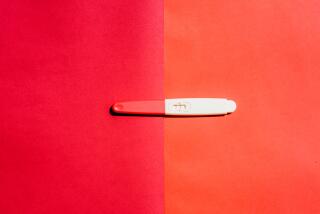Alternative Method Urged to Boost Safety of Fertility Treatments
- Share via
U.S. doctors should radically alter their treatment strategies if they want to stem the tide of medically risky multiple births without lowering the success of fertility treatments, a team of New York and Illinois doctors says.
Writing in today’s New England Journal of Medicine, they present evidence that it is extremely difficult for doctors using the common fertility treatment called ovulation induction to predict the chance of a multiple birth.
The authors suggest that a costlier, alternative treatment--in vitro fertilization--should be substituted in most cases.
“Higher order multiple births--triplets or more--have such a high risk of prematurity, and a higher risk of long-term handicap,” said Dr. Norbert Gleicher, lead author of the study and medical director at the Center for Human Reproduction in New York. “We as a profession have an absolute responsibility to try and minimize them.”
The paper was written by Gleicher and other doctors from the center’s New York and Chicago clinics.
In an accompanying editorial, fertility doctors Allan Templeton and Siladitya Bhattacharya of Scotland’s University of Aberdeen noted that in vitro fertilization--in which eggs are fertilized in a dish--allows a high success rate when very few embryos are returned to the mother’s body.
The impetus for the New England Journal study was a spate of multiple births in the authors’ clinics a year and a half ago. To figure out what was going on, the group examined 3,347 attempts to help 1,494 infertile women who had visited the clinics over 2 1/2 years.
Of these women, 441 got pregnant. There were 88 sets of twins, 22 of triplets, 10 of quadruplets, five of quintuplets and two of sextuplets.
These women were treated with the ovulation induction method, in which eggs are first induced to ripen via a hormone injection. Then the woman is given a second hormone, which releases the eggs for insemination, either naturally or artificially.
Doctors can’t know for sure how many embryos will result, but they try to ward off multiples by viewing the woman’s ovaries with ultrasound to search for large follicles and measuring a hormone the eggs release as they are maturing. If it looks as if too many eggs are maturing, the woman is advised to skip the second injection and wait for the next cycle.
But in the New England Journal study, the scientists found that these criteria didn’t work well in predicting multiple births.
In fact, they add, the only way to reduce the risk of multiples would be to lower the chance of pregnancy. As it is, ovulation induction has only a 15% success rate per attempt.
Thus, the scientists suggest that it’s time to shift focus toward in vitro fertilization, which has come a long way since the early, hit-and-miss days. While it costs more--about $10,000 an attempt versus about $2,000 to $4,000 for each round of ovulation induction--it has a greater success rate. (In most states, health insurance does not cover infertility treatment.)
Dr. Richard Paulson, chief of the fertility division at the USC School of Medicine, said he tentatively agrees with this conclusion. Fertility doctors have known for some time that one can’t reliably predict multiple pregnancies, he said.
But he pointed out that the women in this study were all young--and that ovulation induction does not present as high a risk for women in their late 30s and older.
Gleicher said that the results have already changed treatment at the Center for Human Reproduction. In the past, he said, about 25% of the women would pursue in vitro fertilization, while 75% would pursue ovulation induction. Today the numbers are reversed.
Dr. Alan DeCherney, head of the department of obstetrics and gynecology at UCLA, said that it can be hard to deny ovulation induction to women if they don’t have money for in vitro fertilization. Also, he said, if used conservatively the method can result in fewer multiple births.
According to the Centers for Disease Control and Prevention, rates for births of triplets or more have risen from 29 per 100,000 births in 1971 to 174 per 100,000 in 1997 (the most recent year for which data are available) because of infertility treatments.
Such pregnancies bring problems for the mother, said Dr. Michael P. Nageotte, medical director for the women’s hospital at Long Beach Memorial Medical Center. She may have to decide whether to abort some of the fetuses. She has a heightened risk of severe hypertension, fluid retention and lung and heart problems. And her babies will be born prematurely.
Prematurity--because the baby is not yet fully developed when it is born--brings a whole spate of medical problems, including the risk of long-term disability.
The American Society for Reproductive Medicine revamped its guidelines for in vitro fertilization last November, recommending that no more than two embryos be implanted in young women with the best chance of successful pregnancy (and no more than three to five for older women with lower chances). The society is revamping guidelines for ovulation induction.
The new guidelines--perhaps combined with the publicity surrounding the most spectacular cases of multiple births, and a heightened caution in doctors--may already be effecting change, said Dr. Leonard Weisman, chief of Texas Children’s Hospital Newborn Center, where the Chukwu octuplets were born in December 1998. In the past, he said, the hospital saw at least one set of quints a year and was constantly tending to quads.
“But since the octuplets we’ve seen a dramatic decrease in the number of multiples,” he said. “We haven’t seen quads for over a year. We’ve seen a big decrease in the number of triplets. It’s day and night.”






